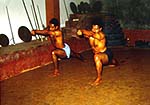


|
|
 |
| HOME | TRAVEL | TRAVELOG | ||

Fists of Fury ... Kalaripayattu, Kerala's martial art form Sashi Kodasseri
He could make no mistake. No wrong moves. Every word he mumbled on screen were like Confucian conversation from the Analects. I could do a kung fu dance on stage in boarding school, with loud rock music in the background, well enough to make me a hero of sorts. And never mind the fact that I didn't know even half a kata or that I kept babbling like a scatter-brained duck every time I spoke. And whatever it seemed like at the time, behind the tough young kid facade lay a meek little jellyfish desperately seeking salvation as a fighting young man. I wanted to be like my God. And solve all my boyish problems with my fists without using my brains. Get my kicks out of a flying kick. And have my pictures plastered on the walls of the rooms and hearts of the young, like Bruce Lee. I ended up becoming a caricature.
I think every street urchin in India dug Bruce Lee even if they did not know who the prime minister of the country was. I remember martial arts schools sprouted like weeds -- karate, kung fu, judo, taek-won-do and, of course, Lee's own style of jeet-kun-do. Every brick-fisted Chuck Norris clone, with Joe Weider boobs to match, who had one six month stint as a karateka claimed to be a 10th dan black belt.
And in Kerala, India's sultry southwestern strip of land, the ancient martial tradition of Kalaripayattu wasted away. Like a dog-eared page from history. The downslide I believe began with the advent of Lee. Local youth found it too down market, preferring instead the glamour of karate, kung fu, taek-won-do and aikido. To complete the butchery of a grand old tradition, the deluge of Hong Kong-made-Jackie Chan farces and Hollywood flicks with grim reapers like Jean-Claude Van Damme and Steven Seagal added that extra touch of marketing necessary to bury it in the pit of oblivion. Very few Kalari schools exist today. Many teachers of the art now make a better living as local ayurvedic physicians. Kalaripayattu is part of an ayurvedic tradition where an advanced student learns herbal medicine and the meridian points in the body. But all is not lost. The Kerala government is trying hard to revive the art (which is widely believed to be the mother of all martial arts) with a series of road shows across the country. And now, with the going-back-to-the-basics trend catching on abroad, there is a burgeoning interest amongst a section of the international electronic media.
The word Kalaripayyatu is of unknown origin, as is the beginning of the art itself. There are many myths and legends attached to it. One legend has it that the art was devised by an ancient king after closely observing animals and insects fight and adapting it for humans. Another says a sage called Sushrutha devised this method of self defence. Then there's a story associated with the mythological character Parashurama who taught the art to 21 devoted disciples to protect the land of Kerala which he created out of the sea with his battle axe. "Those are just stories," says T C Chandran, gurukkal of the Kairali Ayurveda Chikilsa Kendram and the Kairali Kalari Sangam in Calicut, Kerala. He is a second generation Kalaripayattu master and a highly respected local Ayurvedic physician, rolled into one -- the gurukkal. His Ayurveda Chikilsa Kendram, a herbal medical centre which he runs with help from his sons Sooraj and Dhiraj, attracts hordes of folks from all over the city and beyond, seeking release from ailments that allopathy or 'English medicine' has failed to offer them.
Though ayurvedic treatment is Chandran gurukkal's main source of income, he also trains a few chosen sishyans (disciples) in Kalaripayattu. "Most youngsters these days go to karate schools," he sighs. "Kalari is slowly dying. That's why I choose my disciples with care. Only if they are serious about learning this ancient art do I take them on." And sadly there are not too many takers. Photographs by Rajan Kallai
|
|
|
Continued
|
|
|
|
|
|
HOME |
NEWS |
BUSINESS |
CRICKET |
MOVIES |
CHAT
INFOTECH | TRAVEL | LIFE/STYLE | FREEDOM | FEEDBACK |
|